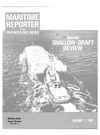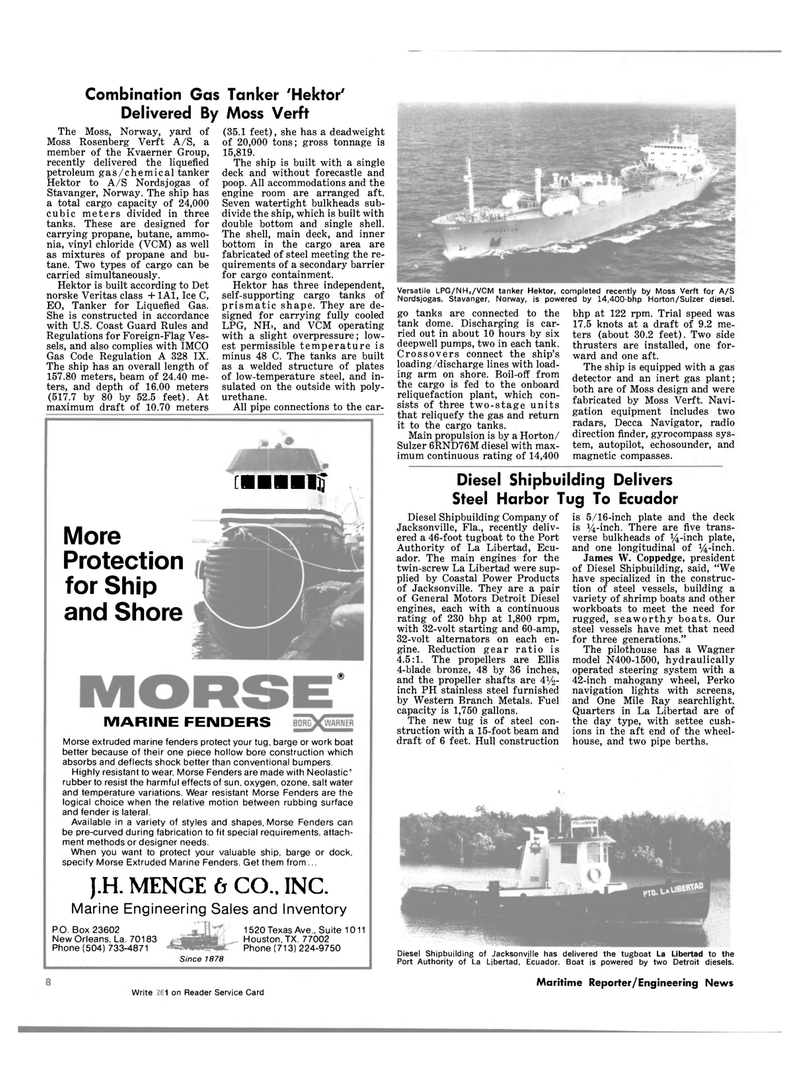
Page 6: of Maritime Reporter Magazine (January 1981)
Read this page in Pdf, Flash or Html5 edition of January 1981 Maritime Reporter Magazine
Combination Gas Tanker 'Hektor'
Delivered By Moss Verft
The Moss, Norway, yard of
Moss Rosenberg Verft A/S, a member of the Kvaerner Group, recently delivered the liquefied petroleum gas/chemical tanker
Hektor to A/S Nordsjogas of
Stavanger, Norway. The ship has a total cargo capacity of 24,000 cubic meters divided in three tanks. These are designed for carrying propane, butane, ammo- nia, vinyl chloride (VCM) as well as mixtures of propane and bu- tane. Two types of cargo can be carried simultaneously.
Hektor is built according to Det norske Veritas class + 1A1, Ice C,
EO, Tanker for Liquefied Gas.
She is constructed in accordance with U.S. Coast Guard Rules and
Regulations for Foreign-Flag Ves- sels, and also complies with IMCO
Gas Code Regulation A 328 IX.
The ship has an overall length of 157.80 meters, beam of 24.40 me- ters, and depth of 16.00 meters (517.7 by 80 by 52.5 feet). At maximum draft of 10.70 meters (35.1 feet), she has a deadweight of 20,000 tons; gross tonnage is 15,819.
The ship is built with a single deck and without forecastle and poop. All accommodations and the engine room are arranged aft.
Seven watertight bulkheads sub- divide the ship, which is built with double bottom and single shell.
The shell, main deck, and inner bottom in the cargo area are fabricated of steel meeting the re- quirements of a secondary barrier for cargo containment.
Hektor has three independent, self-supporting cargo tanks of prismatic shape. They are de- signed for carrying fully cooled
LPG, NHs, and VCM operating with a slight overpressure; low- est permissible temperature is minus 48 C. The tanks are built as a welded structure of plates of low-temperature steel, and in- sulated on the outside with poly- urethane.
All pipe connections to the car- fanaHiT
More
Protection for Ship and Shore ®
MARINE FENDERS
Morse extruded marine fenders protect your tug, barge or work boat better because of their one piece hollow bore construction which absorbs and deflects shock better than conventional bumpers.
Highly resistant to wear, Morse Fenders are made with Neolastic' rubber to resist the harmful effects of sun, oxygen, ozone, salt water and temperature variations. Wear resistant Morse Fenders are the logical choice when the relative motion between rubbing surface and fender is lateral.
Available in a variety of styles and shapes, Morse Fenders can be pre-curved during fabrication to fit special requirements, attach- ment methods or designer needs.
When you want to protect your valuable ship, barge or dock, specify Morse Extruded Marine Fenders. Get them from...
J.H. MENGE 6 CO., INC.
Marine Engineering Sales and Inventory
P.O. Box 23602
New Orleans, La. 70183
Phone (504) 733-4871 1520 Texas Ave., Suite 1011
Houston, TX. 77002
Phone (713)224-9750
Since 1878
Versatile LPG/NH3/VCM tanker Hektor, completed recently by Moss Verft for A/S
Nordsjogas, Stavanger, Norway, is powered by 14,400-bhp Horton/Sulzer diesel. go tanks are connected to the tank dome. Discharging is car- ried out in about 10 hours by six deepwell pumps, two in each tank.
Crossovers connect the ship's loading /discharge lines with load- ing arm on shore. Boil-off from the cargo is fed to the onboard reliquefaction plant, which con- sists of three two-stage units that reliquefy the gas and return it to the cargo tanks.
Main propulsion is by a Horton/
Sulzer 6RND76M diesel with max- imum continuous rating of 14,400 bhp at 122 rpm. Trial speed was 17.5 knots at a draft of 9.2 me- ters (about 30.2 feet). Two side thrusters are installed, one for- ward and one aft.
The ship is equipped with a gas detector and an inert gas plant; both are of Moss design and were fabricated by Moss Verft. Navi- gation equipment includes two radars, Decca Navigator, radio direction finder, gyrocompass sys- tem, autopilot, echosounder, and magnetic compasses.
Diesel Shipbuilding Delivers
Steel Harbor Tug To Ecuador
Diesel Shipbuilding Company of
Jacksonville, Fla., recently deliv- ered a 46-foot tugboat to the Port
Authority of La Libertad, Ecu- ador. The main engines for the twin-screw La Libertad were sup- plied by Coastal Power Products of Jacksonville. They are a pair of General Motors Detroit Diesel engines, each with a continuous rating of 230 bhp at 1,800 rpm, with 32-volt starting and 60-amp, 32-volt alternators on each en- gine. Reduction gear ratio is 4.5:1. The propellers are Ellis 4-blade bronze, 48 by 36 inches, and the propeller shafts are 4y2- inch PH stainless steel furnished by Western Branch Metals. Fuel capacity is 1,750 gallons.
The new tug is of steel con- struction with a 15-foot beam and draft of 6 feet. Hull construction is 5/16-inch plate and the deck is ^-inch. There are five trans- verse bulkheads of ^-inch plate, and one longitudinal of ^-inch.
James W. Coppedge, president of Diesel Shipbuilding, said, "We have specialized in the construc- tion of steel vessels, building a variety of shrimp boats and other workboats to meet the need for rugged, seaworthy boats. Our steel vessels have met that need for three generations."
The pilothouse has a Wagner model N400-1500, hydraulically operated steering system with a 42-inch mahogany wheel, Perko navigation lights with screens, and One Mile Ray searchlight.
Quarters in La Libertad are of the day type, with settee cush- ions in the aft end of the wheel- house, and two pipe berths.
Write 150 on Reader Service Card
Diesel Shipbuilding of Jacksonville has delivered the tugboat La Libertad to the
Port Authority of La Libertad, Ecuador. Boat is powered by two Detroit diesels. 8 Maritime Reporter/Engineering News

 5
5

 7
7
